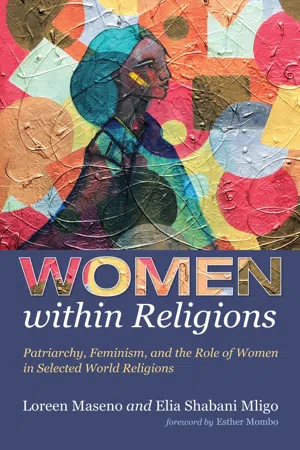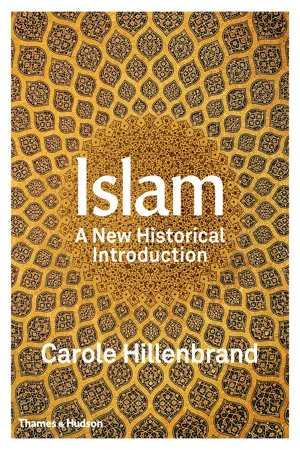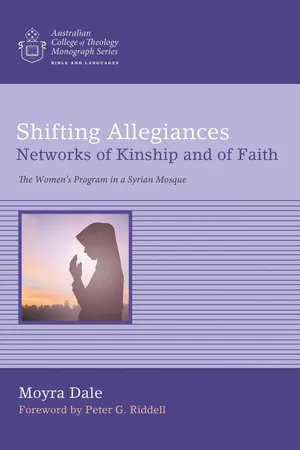History
Women in Islam
Women in Islam have played significant roles throughout history, contributing to various fields such as education, politics, and social welfare. Islamic teachings emphasize the rights and dignity of women, including their right to education, work, and property ownership. While there have been variations in women's rights and status across different Muslim societies and historical periods, women have always been integral to the development and progress of Islamic civilization.
Written by Perlego with AI-assistance
Related key terms
6 Key excerpts on "Women in Islam"
- eBook - ePub
Women within Religions
Patriarchy, Feminism, and the Role of Women in Selected World Religions
- Loreen Maseno, Elia Shabani Mligo(Authors)
- 2019(Publication Date)
- Wipf and Stock(Publisher)
mollas , i.e., religious teachers. These women receive money for the responsibility of holding public sessions in which stories are read about the life of Hussain the martyred grandson of the Prophet. These are usually activities and occasions for women to meet together away from home under the guise of a traditionally sanctioned activity.In general, while women in the Islamic world have been segregated, secluded, and historically considered second-class by males in their communities, they have not been totally without power. They have been able to maintain a degree of control over their own lives and over the lives of men with whom they live through the religious practices described here.ConclusionMany Muslim women wonder that the fruits of liberation in the West are too many broken marriages, women left without the security of men who would provide for them, deteriorating relations between men and women and sexual license that appears as rank immorality. In contrast, they see the Islamic systems affirmed by the Qur’an as one in which male authority over them ensures their care and protection.To many women, Islam provides a structure in which the family is solid, children are inculcated with lasting values, and the balance between the responsibility between man and woman is one in which absolute equality is prized through cooperation and complementarity.Chapter Review1 . How were women conceived during the Jahiliyyah period, i.e., in the period of ignorance?2 . What does the Qur’an say about what was going on in the Arabian Peninsula during the period of ignorance?3 . Has the emergence of Islam reformed the women-subjugating traditions of the pagan Arabian Peninsula? In what way?4 . What does the Qur’an, the scriptures of Islam, say about the role of women in issues of marriage, divorce, inheritance, ownership of properties, dress code, and seclusion?5 . How is the woman depicted in the Islamic tradition (hadith - eBook - ePub
Women in the Middle East
Past and Present
- Nikki Keddie(Author)
- 2012(Publication Date)
- Princeton University Press(Publisher)
Women apparently remained publicly active in the earliest Islamic period, as they had been before, even supporting men in various ways in the warfare that remained frequent during and after Muhammad’s life. This support included loud cries of encouragement near the battlefield, nursing, and occasional combat roles. Women’s public role decreased, however, after the period of conquest that followed Muhammad’s death. Regarding changes in marriage patterns following the rise of Islam, Ahmed says: “Islam selectively sanctioned customs already found among some Arabian tribal societies while prohibiting others. Of central importance to the institution it established were the preeminence given to paternity and the vesting in the male of proprietary rights to female sexuality and its issue. Accordant customs, such as polygamy, were incorporated while discordant or opposing customs were prohibited.” 14 Ahmed, however, distinguishes the ethical gender-egalitarianism of some Quranic verses as a major strain in the Quran that implicitly conflicted with its inegalitarian rules. Men and women, for example, were given the same admonitions regarding charity, chastity, truthfulness, patience, and piety. Ahmed maintains that these two visions of Islam characterized much of later Islamic history. One could argue that the two were not contradictory except in a modern view; that in premodern societies everyone could be asked to adhere to certain ethical and religious standards without an implication that everyone had equal qualities of reason and judgment that entitled them to equal rights. Such views were not exclusive to Islam, but were found in many traditional societies and religions. In Islam as in other religions, there were minority movements that stressed greater equality between men and women, and some who did not accept the Quranic rules regarding women - eBook - ePub
- Marie Failinger, Elizabeth Schiltz, Susan J. Stabile(Authors)
- 2016(Publication Date)
- Routledge(Publisher)
To alleviate this general problem of interpretation and representation, each woman needs to self-identity with Islam (Barazangi 2000). The Muslim woman must realize that, as an individual Muslim, she becomes legally bound by the guidance of Islam only after she ethically and consciously chooses its message as her worldview in its totality. Moreover, the individual Muslim woman is not necessarily bound by most of the secondary sources beyond the Qur`an nor by the rules derived by jurists and interpreters throughout the centuries. This is an urgent issue because I see Muslim women’s reinterpretation of the Qur`an as a response to the crisis in understanding Islam, beginning on the university campuses in the American and other Western countries and reaching as far as the caves of the Taliban. The common English translation of “Islam” as “surrender” or “submission” is not accurate. The word “Islam” (Deen) as emphasized in the Qur`an {The religion before Allah is Islam [to be at peace with Allah’s guidance] (‘Al ‘Imran 3: 18)}, is more accurately understood as a worldview of being at peace with oneself, with society, and with God. 2 Islam is a religio-moral rational worldview that is neither a law nor a dogma of submission, because submission means a rejection of the responsibility for the awareness and understanding the deep meanings of the Qur`an required by verses 14–19 of Chapter (al ‘Alaq 96) to fully practice Islam. The implications of the lack of such awareness and the absence of Muslim women in developing and shaping Islamic thought are numerous (Barazangi 2009, 2008). For purposes of this chapter, though, women’s lack of awareness that, “the Qur`an does not prescribe one timeless and unchanged social structure for men and women” is particularly problematic (Wadud 1999). 2 The brackets {.} refer to the English rendition of the verse(s) of the Qur`an used here to emphasize or clarify a point - eBook - ePub
Islam
A New Historical Introduction
- Carole Hillenbrand(Author)
- 2015(Publication Date)
- Thames and Hudson Ltd(Publisher)
It has generally been supposed in the West that women have always occupied a lowly if not servile position in the Islamic social hierarchy and that they were, and are, virtually the property first of their fathers, and then of their husbands. But the situation is much more complex and nuanced than that. Nor should people in the West forget that it was not so long ago in their own culture that women were denied the vote, debarred from tertiary education, excluded from many professions, and forbidden to own property on the same terms as men. Gender issues to do with Muslim societies are generally represented in Western discourse as clashing with values such as human rights and sexual freedom for women. The West seems to pull in one direction; indeed, the “liberation of Muslim women” was an aim of European colonizing governments in the nineteenth century and is still part of the agenda for Western intervention today in the Middle East. On the other side, this “missionary” stance on the part of the West has provoked a strong response from Islamist groups. It strengthens their resolve to maintain in their own countries, both by legislation and also by brute force on the streets, the long-standing customs that circumscribe the lives of Muslim women and dictate to them what they may do, where they may go, and what they should wear. 5 More recently, a third force is pulling from within Muslim societies in yet another direction; Muslim feminist groups, supported by many Muslim men, are seeking to establish, once and for all, equal rights for Muslim women across the world (see pp. 269–72). Dress sense. Women strolling along the corniche in Beirut, Lebanon. As in many other countries—including those of the West—clothing is evidently no bar to easy social interaction among women. So an entirely veiled woman may be seen walking hand in hand with a friend wearing a miniskirt. It is they who decide what works for them - eBook - ePub
Shifting Allegiances: Networks of Kinship and of Faith
The Women's Program in a Syrian Mosque
- Dale(Author)
- 2016(Publication Date)
- Wipf and Stock(Publisher)
2Women and Text in Islam
A female religious scholar of fifteenth-century Hadramawt, Yemen, al-Shaykha Sultana bint ‘Ali al-Zubaydy was well-known for her piety, knowledge, and teachings. One of her male counterparts, expressing the conventional opinion that religious scholarship and teaching were the domain of men, challenged her in verse: “But can a female camel compete with a male camel?” She completed the couplet, responding: “A female camel can carry the same load as a male, and produce offspring and milk as well.”3Women and the Coming of IslamT he place of women within Islam has been much debated.4 While a number of writers agree that women had some freedom in the time of Muhammad,5 Jawad considers that it was because Muhammad elevated women’s status from their pre-Islamic state.6 In contrast Ahmed suggests that women’s active role in society was progressively curtailed by the establishment of Islam and the privileging of patrilineal, patriarchal marriage.7 Hekmat and Mernissi8 agree that polygamy was not widespread at the time of Muhammad, and Ahmed and Engineer9 indicate that women as well as men had been able to initiate divorce in the time of the jahiliyyah . Ahmed proposes that the lives of Khadija and ‛ Aisha embody the change brought by Islam: “[Khadija’s] economic independence; her marriage overture, apparently without a male guardian to act as intermediary; her marriage to a man many years younger than herself; and her monogamous marriage all reflect Jahilia rather than Islamic practice.” ‛ Aisha, in contrast “was born to Muslim parents, married Muhammad when she was nine or ten, and soon thereafter, along with her co-wives, began to observe the new customs of veiling and seclusion.” Ahmed concludes that through selectively sanctioning some practices and prohibiting others, “Islam fundamentally reformulated the nexus of sexuality and power between men and women.”10 - eBook - ePub
- Asma Lamrabet, Muneera Salem-Murdock(Authors)
- 2018(Publication Date)
- Palgrave Macmillan(Publisher)
The conduct of these women of the first community confirms the historical information of the era that chronicles the visible presence of women in all of the major events that marked this period. The feminine demand was nothing short of a legitimate questioning by these women, wanting to understand, with precision, their correct place in the Qur’ānic discourse, thereby confirming their role as equal partners alongside men. This feminine demand of this first hour also illustrates the birth of a new female consciousness, informed and fully aware of its rights and responsibilities—rights and responsibilities granted to them directly and officially by the liberating message of Islam.These first Muslim women actively participated in the erection of the first city of Islam under the protection and with the unconditional encouragement and support of the Prophet, who not only was one of the greatest defenders of the female cause but also of all the oppressed on earth. Needless to say, women were among the most oppressed minorities during this period. These women, therefore, sacrificed themselves, sometimes at the risk of their own lives, for the edification of the new spiritual message. In exile, they gave the best of themselves—dedication, separation from their loved ones, insecurity, poverty, sufferance, all of which they accepted with joyous and hopeful hearts, knowing they were now free, autonomous, and independent. Islam had given these women a new social status as human beings, dignified, free, and on equal footing as men.This is exactly why these women protested and complained to the Prophet; they were exercising their newly acquired rights and wanted to be directly addressed in the Qur’ān in the same fashion as men; and even though, deep down, they knew full well that the Divine had not ignored them and that which had been newly revealed involved them as much as it did men, they wanted to be reassured. In this context, the dawn of Islam, what could have been more natural for these women, triumphant in terms of their newly acquired rights, than to assert their presence by actively seeking clear answers to their aspirations? They rightly felt a need for such confirmation, an ultimate testimony
Learn about this page
Index pages curate the most relevant extracts from our library of academic textbooks. They’ve been created using an in-house natural language model (NLM), each adding context and meaning to key research topics.





